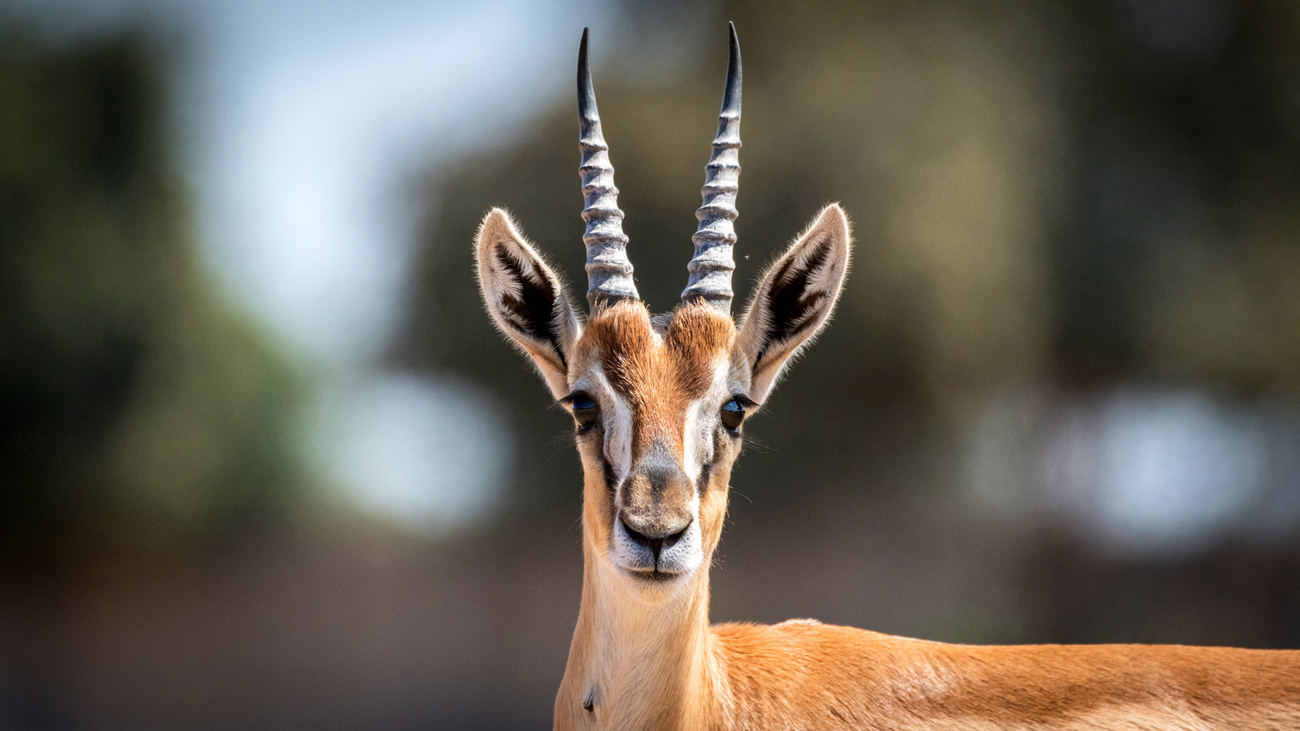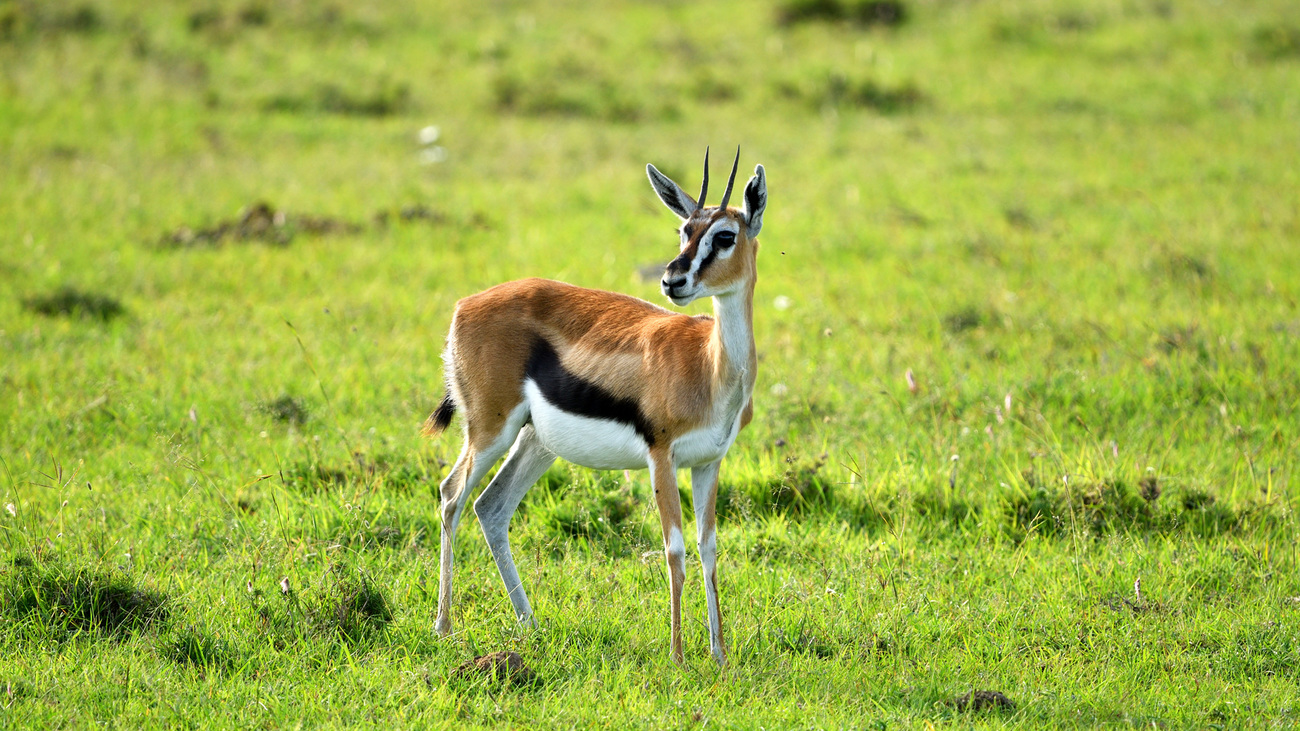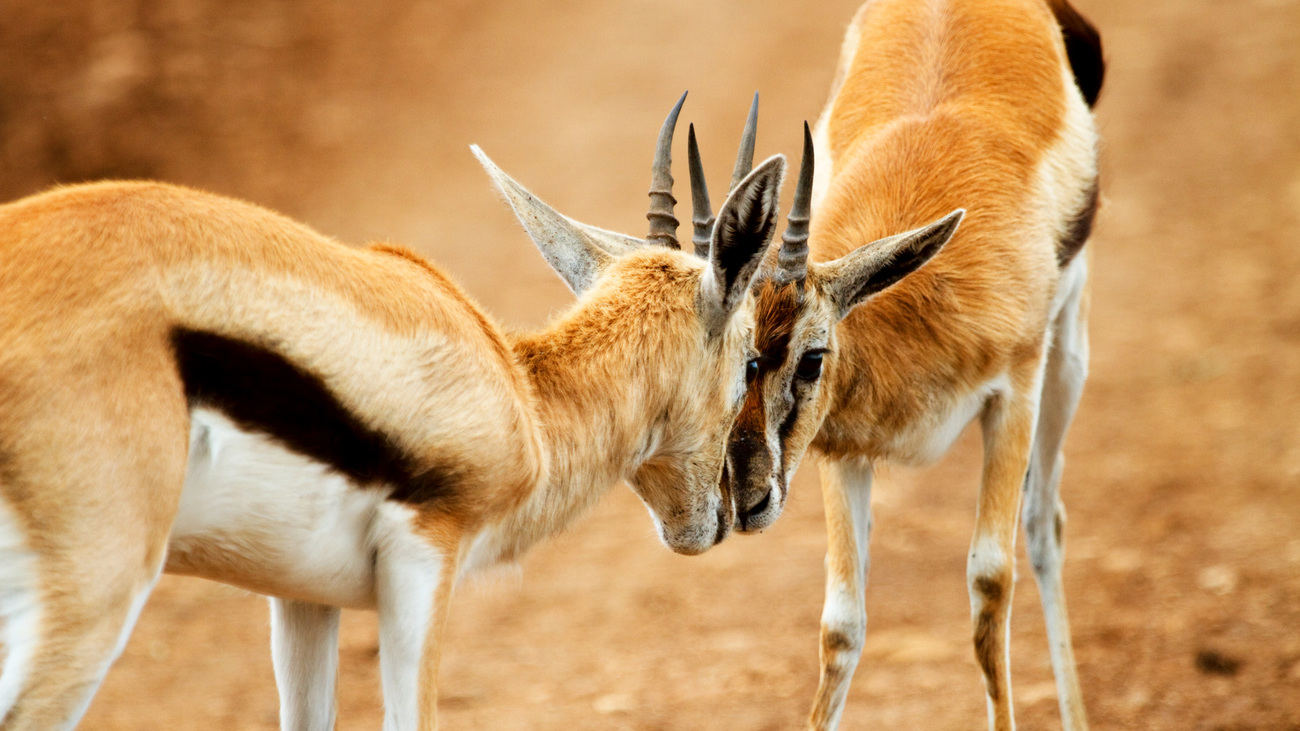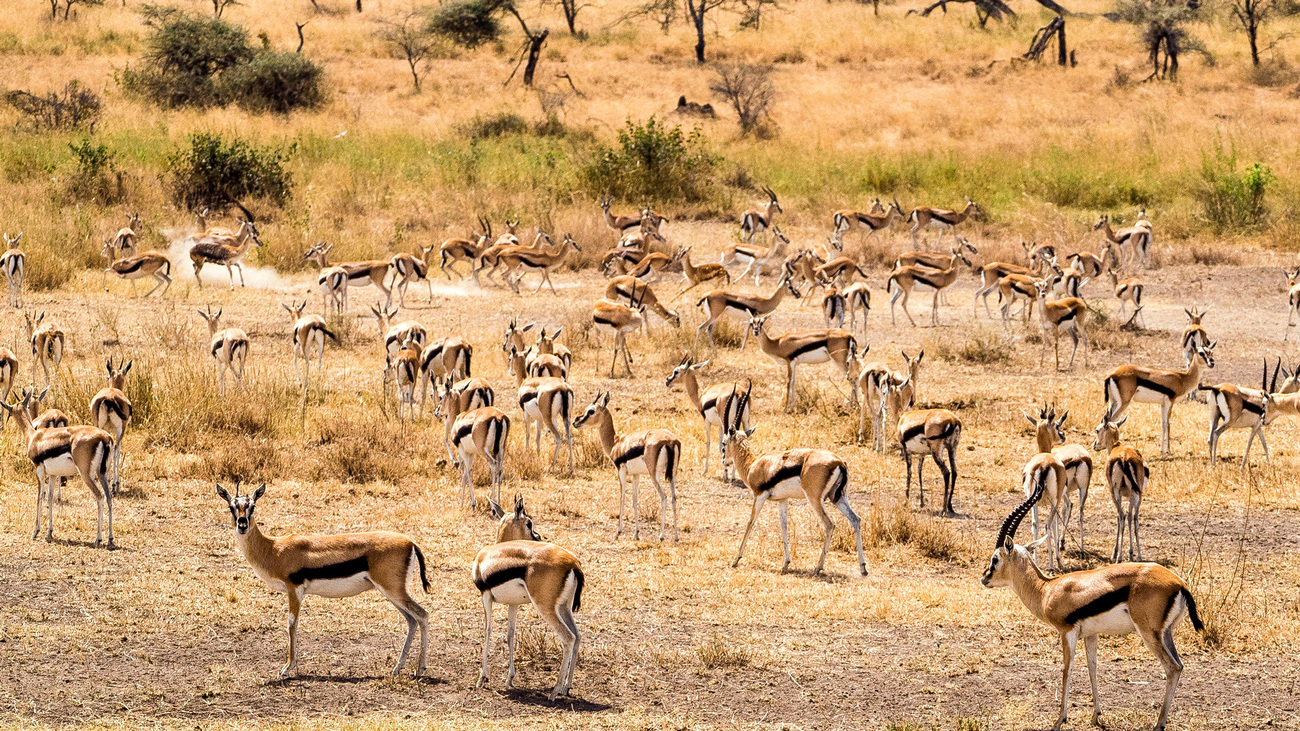Thomson’s gazelles
What is Thomson’s gazelle?
Named after Joseph Thomson—a 19th-century geologist and explorer—Thomson’s gazelles are small- to medium-sized antelopes native to East Africa. Colloquially known as ‘tommies’, they are predominantly found in the savannahs and grasslands of countries like Kenya and Tanzania. They thrive in wide-open spaces and plains, and they live together in herds.
These gazelles are relatively small and slender in build, particularly when compared to other antelope subspecies. Thomson’s gazelles have a tan to reddish-brown coat with a white belly and distinct black stripes on their sides and flanks. Adults typically stand about 55 to 82 centimetres tall at the shoulder and weigh 15 to 35 kilograms.
Due to their relatively small size, they are a preferred prey species for several large predators, including cheetahs, lions, leopards, and wild dogs. However, Thomson’s gazelles have developed great agility and speed to help them escape predators. In fact, they can reach speeds of up to 65 kilometres per hour when chased.
Thomson’s gazelles are herbivores that eat a variety of grasses, shoots, and leaves. They are highly selective in their diet and have adapted to graze on the most nutritious grasses available in their habitat. They are also known for their social nature. They form herds consisting of both males and females that can range from a few to several hundred individuals.
When it comes to mating, males are territorial and engage in courtship displays to attract mates. Thomson’s gazelles give birth to a single calf after a gestation period of around six months. Calves are born with a spotted coat and stay hidden in grass or bushes to avoid predation during their early days. They are weaned at about two to three months and reach sexual maturity at around one to two years old.
Thomson’s gazelles play a crucial role in maintaining the health of their ecosystems. By eating a wide range of vegetation, they help disperse seeds through their droppings, enabling more plants to grow and helping to sustain other herbivores that share their habitats. They also provide sustenance for larger predators, keeping the food web stable.
Protecting Thomson’s gazelles is essential not just for the survival of the species, but also for the other animals who share their ecosystems. Though they are not currently endangered, conservationists are hard at work to ensure their population numbers don’t decline.
What is Thomson’s gazelle’s scientific name?
The scientific name for Thomson’s gazelle is Eudorcas thomsonii.
Eudorcas is a genus of antelope, while Thomsonii is a reference to Joseph Thomson, a 19th-century geologist and explorer after whom the species was named.
Are Thomson’s gazelles endangered?
Thomson’s gazelles have been classed as least concern by the IUCN since the species was last evaluated in 2018. This is a marked improvement on the near threatened status they held in 2008.
Thomson gazelles were at risk of endangerment at the end of the last century. From the 1970s to the early 2000s, populations declined by as much as 70% in several places, including in the Serengeti, Masai Mara, and Ngorongoro where gazelles once thrived. However, this decline has now slowed, with Thomson’s gazelles experiencing just an 8% drop in numbers between 2002 and 2014.
Where do Thomson’s gazelles live?
Thomson’s gazelles primarily inhabit the grasslands, savannahs, and open plains of East Africa, in countries like Kenya and Tanzania. They are commonly found in both lowland and highland areas within these regions and have adapted to thrive in semi-arid and arid environments.
Threats
Thomson’s gazelles face a range of threats, largely related to human expansion and climate change.

Droughts and water availability
Thomson’s gazelles inhabit semi-arid and arid regions, which are prone to periodic droughts. When no rain falls for long stretches of time, water sources become scarce, and the plants on which gazelles depend for food struggle to grow.
This is particularly problematic in Kenya, which is experiencing its worst drought in 40 years. With too little water for plants to grow, animals across the country are struggling to find food and water. Malnourished and dehydrated, herbivores struggle to summon the energy to escape predators, resulting in high mortality rates. This then has a domino effect on the entire ecosystem.
Habitat loss
Human activities—such as agriculture, infrastructure development, and urban expansion—have disturbed and destroyed a lot of the grassland habitats on which Thomson’s gazelles depend.
When their natural habitat is converted for human use, these gazelles are forced into smaller, isolated pockets of land, making them more vulnerable to predation and reducing their access to food and water.
Hunting
Gazelles often congregate on ranches and farmlands after other animals have vacated them, feeding on the short grasses left exposed by cattle. Here, they are easy targets for disgruntled farmers and are often shot or snared for food.
Thomson’s gazelles are also sought after by trophy hunters and poachers for their horns and meat. Despite legal restrictions, illegal hunting poses a significant threat to their population levels. Additionally, the gazelles’ predators, such as cheetahs and lions, also face threats from retaliatory killing by livestock owners, which indirectly affects the species’ survival.
Competition for food
As herbivores, Thomson’s gazelles compete with other herbivorous species for food resources in their habitat. The decline of Thomson’s gazelle populations in the Serengeti has been linked to the increase in the number of wildebeest, with whom they compete for food.
Similarly, as farmland and livestock spread further into the wilderness, domestic animals like cattle and goats consume the same grasses and vegetation as gazelles, creating further competition.
Conservation efforts—including establishing protected areas, sustainable land management, anti-poaching measures, and monitoring of water sources during droughts—are essential to combating these threats and promoting the long-term survival of Thomson’s gazelles.
FAQs
To understand a little more about this fascinating species, let’s explore some facts about Thomson’s gazelle.
What do Thomson’s gazelles look like?
Thomson’s gazelles have distinctive markings. They have light brown coats with dark stripes running down their sides, a white patch on their rumps which extends underneath the tail, and two ridged horns that curve backwards.
Females can easily be identified as most have no horns. The females that do have horns sport ones which are much smoother, shorter, and slimmer than a male’s.

Do female Thomson’s gazelles have horns?
While some female Thomson’s gazelles have short horns, most do not have any.
The presence of horns in female Thomson’s gazelles has been a subject of debate among experts, with some claiming that the slow disappearance of females’ horns is an example of evolution in action.
A commonly accepted theory is that females are evolving to have no horns at all for multiple reasons. The first is to stay inconspicuous in large open spaces with minimal cover; the second is to make it easier for mature males to identify and chase young males away from the herd.
How big are Thomson’s gazelles?
Thomson’s gazelles are relatively small and slender, making them prime prey for larger animals like lions, leopards, and hyenas. Adult males typically are about 55 to 82 centimetres tall at the shoulder and weigh between 15 and 35 kilograms. Female gazelles are typically smaller and weigh less than the males.
What’s the difference between Grant’s gazelle and Thomson’s gazelle?
At first glance, these two gazelle species look very similar. However, upon closer inspection, they have different markings. Thomson’s can be distinguished from Grant’s gazelle by its smaller size and the white patch on its rump. Grant’s gazelle’s patch always extends above its tail.
What’s the difference between a springbok and Thomson’s gazelle?
The main differences between a springbok and Thomson’s gazelle are their geographic ranges and physical characteristics.
Springboks are found in southern Africa and have a reddish-brown coat with a distinctive white face and rump patch. Both males and females have long, lyre-shaped horns. In contrast, Thomson’s gazelles are native to East Africa and have a tan to reddish-brown coat with black stripes on their flanks. Only males have shorter, curved horns.
Additionally, Thomson’s gazelles exhibit more social behaviour and are known to form large herds, while springboks are known for their ‘pronking’ behaviour, in which they leap into the air to evade predators.

Are Thomson’s gazelles antelopes?
Yes, Thomson’s gazelles belong to the genus Eudorcas, which is a group of African antelopes. Gazelles are part of the Antelopini tribe, which also includes the gerenuk and the springbok.
They are part of the Bovidae family, which includes various species of antelope, cattle, and other related animals.
Why are they called Thomson’s gazelles?
The first recorded use of the name Thomson’s gazelles dates back over a century to 1897. The species is named after the Scottish explorer Joseph Thomson. A common nickname for the gazelle is the ‘tommie’.
What do Thomson’s gazelles eat?
As herbivores, Thomson’s gazelles eat grasses, leaves, shoots, and shrubs. During the dry season, short grass makes up around 90% of the Thomson’s gazelle’s diet. The other 10% is made up of seeds and shrubbery.
The gazelles rely on other animals to help secure their food. They will hover around larger mammals, like wildebeest and zebra, who trample and graze on tall grass. This flattened grass is a lot easier for gazelles to eat.
What eats Thomson’s gazelles?
Thomson’s gazelles are a food source for several large mammals, including cheetahs, lions, leopards, hyenas, and wild dogs. Humans also hunt Thomson’s gazelles for food.
How fast can Thomson’s gazelle run?
Thomson’s gazelle can reach speeds of 65 kilometres per hour (40 miles per hour), which is essential for escaping less agile predators.
Do Thomson’s gazelles migrate?
Though Thomson’s gazelles move seasonally, they aren’t considered true long-distance migrants. They occasionally undertake relatively short-distance migrations in response to changing environmental conditions, particularly for access to water and fresh forage.
What is the lifespan of Thomson’s gazelles?
The lifespan of Thomson’s gazelle in the wild is typically 10 to 12 years.
Why are Thomson’s gazelles almost extinct?
Thankfully, the gazelle’s threatened status has been reversed in the last decade. They are now classed as near threatened. However, conservation efforts are still important to keep the species healthy and thriving, as they still face a number of threats. These include drought, water availability, competition for food, hunting, and habitat loss.
How can you help?
Conservation efforts are important for protecting species like Thomson’s gazelle. Support IFAW’s conservation projects to preserve biodiversity and protect our planet.
